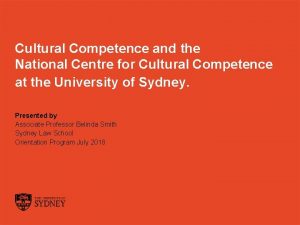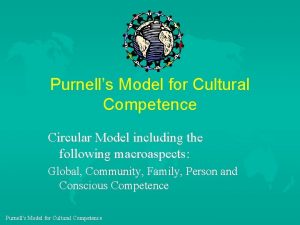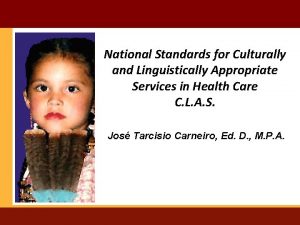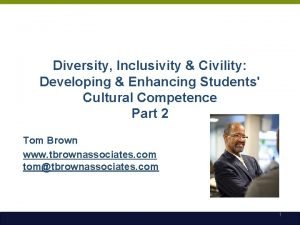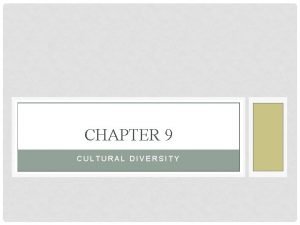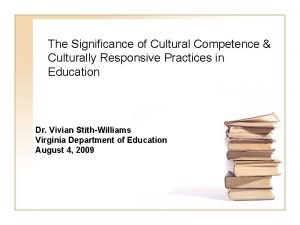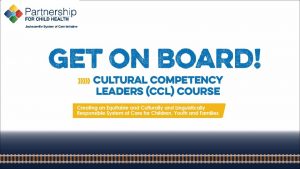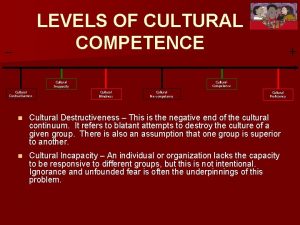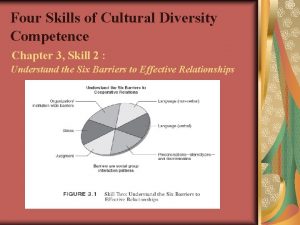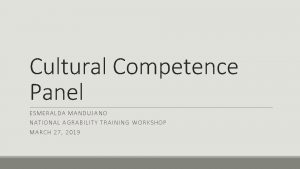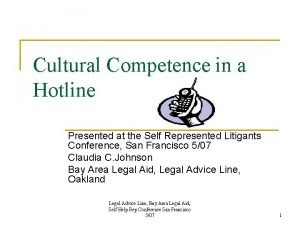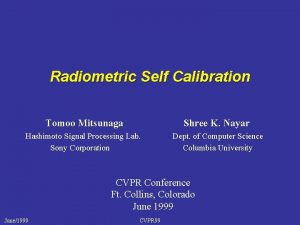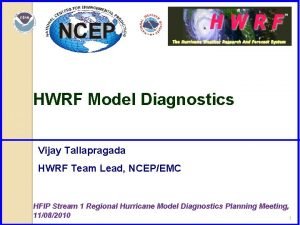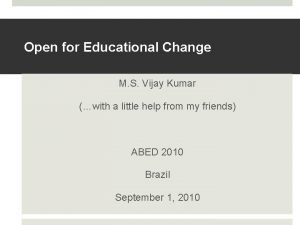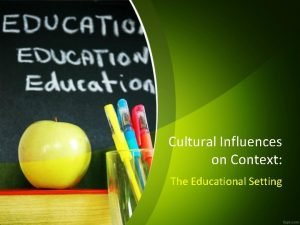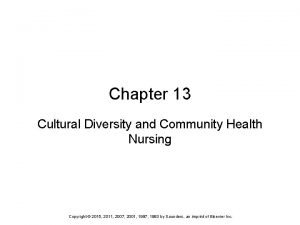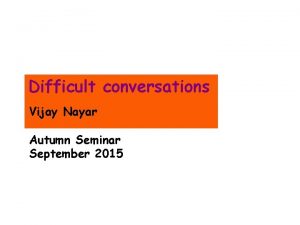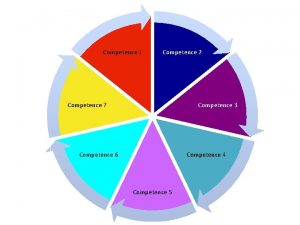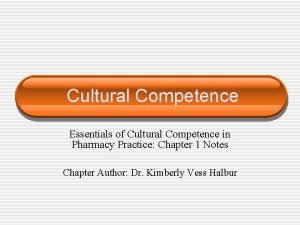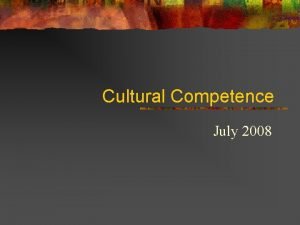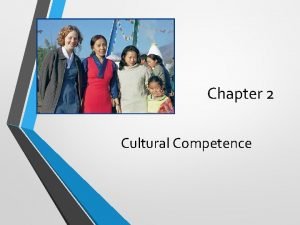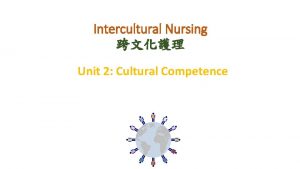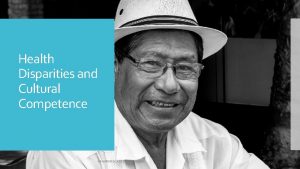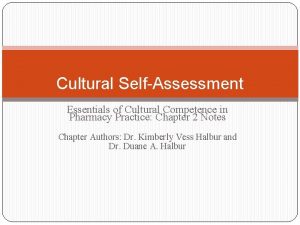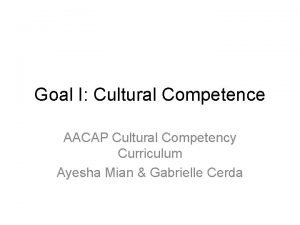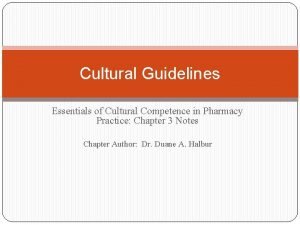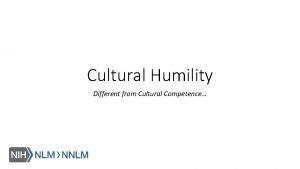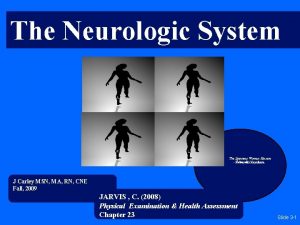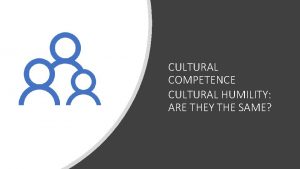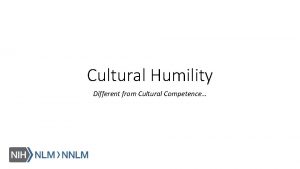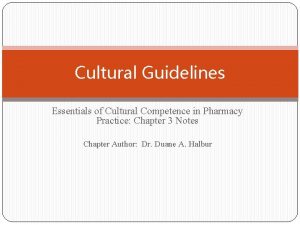Cultural Competence in Health Education Vijay Nayar Autumn




















































- Slides: 52

Cultural Competence in Health Education Vijay Nayar Autumn Seminar September 2015

Why are we doing this? • Increasing diversity of: – Population – Workforce – Trainees • Legislative frameworks - Equality Act (2010)



East of England • Population of 5. 8 million people • Higher than average proportion of people aged over 65 yrs • Approximately 400, 000 people from nonwhite backgrounds • Highest concentration of Gypsies and Travellers in its population compared to the rest of England.

Doctors by PMQ

Why are we doing this? • Promoting Equality and Valuing Diversity is a section of the GP curriculum • Part of the Foundation curricula • Part of many other specialties curricula

Why are we doing this? • Relevant to clinical care • Relationships with patients • Working with colleagues • Helps to reduce Health Inequalities

Cultural competence • Equality and Diversity, Culture, Race, Ethnicity • Health inequalities and literacy • Epidemiology of population health in different cultures • Healing traditions and beliefs

Cultural competence • Cross-Cultural Clinical Skills, language barriers, using interpreters • Self-awareness of own culture, assumptions, stereotypes, biases and their impact • Impact of culture on learning and teaching

Health inequalities and literacy Epidemiology of population health in different cultures


Health Literacy A person with adequate health literacy is someone with the perception, reasoning and language knowledge for accessing, understanding and applying information for healthy living and keeping medically fit. (WHO, 1998)

Individual Organisational Professional Poor Health Literacy Poor Health Outcomes

Health Illiteracy • mainly older • educated to lower standards • in low paid employment • lower socioeconomic influence • mostly of ethnic minorities • those with disabilities Ø poorer knowledge about health Ø acquire poor preventive care Ø poorer CDM Ø poorer mental health Ø attend A/E more often Ø admitted into hospital more frequently

Individual Organisational Poor Health Literacy Professional Cultural Competence Poor Health Outcomes

Equality Ethnicity Culture Diversity Race

Diversity The recognition and valuing of difference between people

Dimensions of diversity, some more visible than others • • Gender Age Ethnicity Nationality Language Skin colour Religion Disability • Class (wealth, education) • Occupation • Sexual orientation • Political orientation • Culture (beliefs, expectations, behaviour)

Equality Is about creating a fairer society in which everyone has the opportunity to fulfil their potential


Equality Act (2010)- Prohibited Conduct 1. Direct discrimination, including by association and perception 2. Indirect discrimination – now covers all characteristics 3. Harassment 4. Third party harassment 5. Victimisation Ø Duty to make reasonable adjustments

Diversity and Equal Opportunities • Not about treating everyone the same • More about providing a LEVEL PLAYING FIELD • Equal access to opportunities

Defining terms. . . • Race • Ethnicity • Culture

Race Ø A socially defined population that is derived from distinguishable characteristics that are genetically transmitted eg skin colour, facial features, hair texture

Ethnicity Ø The belonging to a social group often linked by race, nationality, religion and language often with a common cultural heritage.

Race Culture Religion Ethnicity Language Nationality Country of origin

Culture Ø Shared beliefs, values and attitudes that guide the behaviour of group members

Culture • Shared beliefs, values and attitudes that guide behaviour of members • Complex social phenomenon, multidimensional • Dynamic concept - keeps changing • We are all multicultural but selective

Create working culture that recognise, respect, value and harness difference Ability to respond to their healthcare needs Cultural Competence Ability to interact with different cultures Recognition and valuing of difference between people

• Communication • Assessment • Care provision • Self awareness • Culture biases • Different cultures Knowledge Skills Attitudes • Valuing diversity • Respecting individuality

Cross-Cultural clinical skills, language barriers, using interpreters

Barriers to communication • • Language Accent Nonverbal cues misinterpreted Cultural assumptions and stereotypes Preconceptions Attitude towards another culture Ethnocentricity Unconscious bias

Barriers to communication • Lack of knowledge of healthcare system • Differences in health seeking behaviour • Doctor-patient roles unclear: – doctor centred – patients “told” what to do and they accept this – not used to being asked about their I, C, E – Not used to shared management plan • May be normal for children of elderly folk to be part of decision making

Consequences of poor communication • May make people appear awkward or difficult • Lack of English can make someone appear less intelligent, or lack sense of humour • Misinterpretation • “I don’t know how to help this person” – “Heartsink” patient

Overcoming barriers Building relationship Assessing patient’s problems Managing patient’s problems

Cultural knowledge about. . . • • • Family life Attitude to illness Death and bereavement Sexual issues Dietary restrictions, alcohol Childbirth, circumcision

Impact of culture on learning and teaching

Influence of Culture on Learning and Performance Overseas Trainees confronted by a: • new culture • different educational system • different learning and teaching styles

Culture is not an excuse for poor performance but may put it into context

Power distance • In some cultures – quite large power distance teacher to student, led by teacher, not contradicted or criticised • In others - increasingly more self directed, encouraging to challenge knowledge Ø Potential implications – no experience of challenging or debate therefore unable to unpack the knowledge, difficulty with SDL

Individualism vs. Collectivism • Think of themselves as an individual with a focus on ‘I’ • Individual excellence is nourished and celebrated • Learn to intuitively think of themselves as part of a group/family focusing on ‘we’ • Unquestioning loyalty is expected and assumed

Potential implications • Exams are focussed on evidence of knowledge and recall vs knowledge applied to practice – requiring demonstration of critical reasoning • Need to maintain ‘face’, do not like ‘I don’t know’ – see it as a threat • Difficulty managing uncertainty

Useful interventions • • Induction and preparatory work Discuss their approaches to learning Supervision and Support Mentorship Feedback on performance-good and bad Correct performance problems as they occur Encourage resilience

Implications for Educators Ø Be aware of your own cultural assumptions and biases Ø Appreciate the extent to which difficulties that arise are due to cultural factors Ø “Reality shock” and need to deal with unmet expectations Ø Induction – not only policies and procedures but also “cultural induction”

Cultural Induction • Raise awareness of culture – its effects on learning – its effect on performance • Discuss models of learning • Requirements of exams • Educational contract – this is not prejudice

Cultural Induction • Help their frustration and other emotions • Fear of failure/criticism • Self Directed Learning • Reflective practice • Managing uncertainty • Encourage resilience

Communication skills: • Deconstruct language • Problem solving skills • Overcoming artificiality and being formulaic • Interpersonal skills • Verbal and non-verbal cues • Subtleties and nuances of language • Doctor-Patient relationship

Professionalism • GMC • Confidentiality • Leadership and Teamworking Ø Feedback on performance-good and bad Ø Correct performance problems as they occur Ø Role modelling and Reflective practice

Cultural Competence • It’s always OK to ask • Keep questioning your assumptions • Remember– • culture is complex and multidimensional • culture is dynamic, not static • most people are a mixture of cultures

Cultural competence Rationale, context, definitions Health inequalities and literacy Epidemiology of population health Healing traditions and beliefs Cross-Cultural Clinical Skills Understanding language barriers and working with interpreters • Self-awareness of own culture, assumptions, stereotypes, biases and their impact • Impact of culture and learning and teaching • • •

“The journey towards cultural competence is difficult and fraught with hazard. It also promises personal enrichment and selfdiscovery for those prepared to put in the effort. ” Laird (2008)
 Vijay nayar
Vijay nayar Example of cultural destructiveness
Example of cultural destructiveness Kcadv certification
Kcadv certification National centre for cultural competence
National centre for cultural competence Purnell's model for cultural competence
Purnell's model for cultural competence Konsep kompetensi budaya
Konsep kompetensi budaya Naeyc pathways to cultural competence checklist
Naeyc pathways to cultural competence checklist Staircase self-assessment model
Staircase self-assessment model Understanding civility and cultural competence
Understanding civility and cultural competence Chapter 9 cultural diversity
Chapter 9 cultural diversity Cultural competence on resume
Cultural competence on resume Cultural competence
Cultural competence Terry cross cultural competence
Terry cross cultural competence Cultural proficiency continuum
Cultural proficiency continuum Nea cultural competence
Nea cultural competence Four skills of cultural diversity competence
Four skills of cultural diversity competence Cultural competence
Cultural competence Cultural competence
Cultural competence Moon torrance model
Moon torrance model Element examples
Element examples Shree nayar
Shree nayar Vibhu nayar ias
Vibhu nayar ias Iit delhi polymer science
Iit delhi polymer science Nitin nayar
Nitin nayar Differences between health education and physical education
Differences between health education and physical education Difference between health education and health propaganda
Difference between health education and health propaganda Pavan kumar vijay
Pavan kumar vijay Vijay jeshang
Vijay jeshang Vijay kharadi ias
Vijay kharadi ias Vijay aswani md obituary
Vijay aswani md obituary Vijay tallapragada
Vijay tallapragada Vijay samant
Vijay samant Vijay bhattiprolu
Vijay bhattiprolu Vijay saraswat
Vijay saraswat Ias
Ias Iihs moodle
Iihs moodle Pavan kumar vijay
Pavan kumar vijay Vijay
Vijay Vijay sathaye
Vijay sathaye Dr. vijay kumar
Dr. vijay kumar Vijay tewari
Vijay tewari R. vijay krishna
R. vijay krishna Vijay ramchandani
Vijay ramchandani Cultural context of education
Cultural context of education Culturological assessment
Culturological assessment Jackral
Jackral God of war winter spring summer autumn
God of war winter spring summer autumn Thanksgiving is celebrated in autumn fact or opinion
Thanksgiving is celebrated in autumn fact or opinion Spring is green summer is bright song
Spring is green summer is bright song Similar
Similar Weather spring summer autumn winter
Weather spring summer autumn winter What are the months of spring?
What are the months of spring? Describing winter season
Describing winter season



